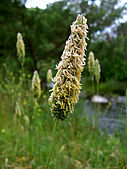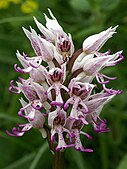
Back Bedeksadiges Afrikaans ክንንብ ዘር Amharic Magnoliophyta AN फूल ANP كاسيات البذور Arabic সপুষ্পক উদ্ভিদ Assamese Magnoliophyta AST ТӀогьолаб гъветӀ-хер AV Çiçəkli bitkilər Azerbaijani چیچکلی بیتکیلر AZB
| Flowering plant Temporal range:
| |
|---|---|
| Scientific classification | |
| Kingdom: | Plantae |
| Clade: | Tracheophytes |
| Clade: | Spermatophytes |
| Clade: | Angiosperms |
| Groups (APG IV)[1] | |
| |
| Synonyms | |
Flowering plants are plants that bear flowers and fruits, and form the clade Angiospermae (/ˌændʒiəˈspərmiː/).[5][6] The term 'angiosperm' is derived from the Greek words ἀγγεῖον / angeion ('container, vessel') and σπέρμα / sperma ('seed'), meaning that the seeds are enclosed within a fruit. The group was formerly called Magnoliophyta.[7]
Angiosperms are by far the most diverse group of land plants with 64 orders, 416 families, approximately 13,000 known genera and 300,000 known species.[8] They include all forbs (flowering plants without a woody stem), grasses and grass-like plants, a vast majority of broad-leaved trees, shrubs and vines, and most aquatic plants. Angiosperms are distinguished from the other major seed plant clade, the gymnosperms, by having flowers, xylem consisting of vessel elements instead of tracheids, endosperm within their seeds, and fruits that completely envelop the seeds. The ancestors of flowering plants diverged from the common ancestor of all living gymnosperms before the end of the Carboniferous, over 300 million years ago. In the Cretaceous, angiosperms diversified explosively, becoming the dominant group of plants across the planet.
Agriculture is almost entirely dependent on angiosperms, and a small number of flowering plant families supply nearly all plant-based food and livestock feed. Rice, maize and wheat provide half of the world's staple calorie intake, and all three plants are cereals from the Poaceae family (colloquially known as grasses). Other families provide important industrial plant products such as wood, paper and cotton, and supply numerous ingredients for beverages, sugar production, traditional medicine and modern pharmaceuticals. Flowering plants are also commonly grown for decorative purposes, with certain flowers playing significant cultural roles in many societies.
Out of the "Big Five" extinction events in Earth's history, only the Cretaceous–Paleogene extinction event had occurred while angiosperms dominated plant life on the planet. Today, the Holocene extinction affects all kingdoms of complex life on Earth, and conservation measures are necessary to protect plants in their habitats in the wild (in situ), or failing that, ex situ in seed banks or artificial habitats like botanic gardens. Otherwise, around 40% of plant species may become extinct due to human actions such as habitat destruction, introduction of invasive species, unsustainable logging, land clearing and overharvesting of medicinal or ornamental plants. Further, climate change is starting to impact plants and is likely to cause many species to become extinct by 2100.
- ^ APG 2016.
- ^ Cronquist 1960.
- ^ Reveal, James L. (2011) [or later]. "Indices Nominum Supragenericorum Plantarum Vascularium – M". Archived from the original on 27 August 2013. Retrieved 28 August 2017.
- ^ Takhtajan 1964.
- ^ Lindley, J. (1830). Introduction to the Natural System of Botany. London: Longman, Rees, Orme, Brown, and Green. xxxvi. Archived from the original on 27 August 2017. Retrieved 29 January 2018.
- ^ Cantino, Philip D.; Doyle, James A.; Graham, Sean W.; et al. (2007). "Towards a phylogenetic nomenclature of Tracheophyta". Taxon. 56 (3): E1–E44. doi:10.2307/25065865. JSTOR 25065865.
- ^ Takhtajan 1980.
- ^ Christenhusz, M. J. M.; Byng, J. W. (2016). "The number of known plants species in the world and its annual increase". Phytotaxa. 261 (3): 201–217. doi:10.11646/phytotaxa.261.3.1. Archived from the original on 6 April 2017. Retrieved 21 February 2022.





